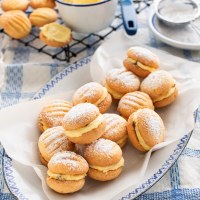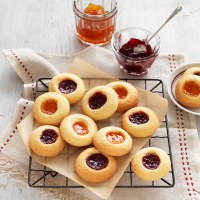The secret to making good shortbread
Combine three ingredients - sugar, butter and flour - to make shortbread. A delicious, buttery biscuit that is wonderful for afternoon tea, or sandwiching two biscuits together with filling to make yoyos and other treats. Here's the recipe and a few simple tricks to help you make lighter, crispier, better biscuits!
3 ingredient shortbread recipe
INGREDIENTS
- 200g Western Star Chef’s Choice Butter, chopped, softened
- ⅔ cup (100g) icing sugar mixture, plus extra for serving
- 1½ cups (225g) plain flour
METHOD
- Preheat oven to 160°C (fan-forced) and line 2 baking trays with baking paper
- Beat butter and sugar in a large bowl of an electric mixer until light and fluffy. Add sifted flour and mix on low until combined
- Turn out the dough onto a lightly floured work surface and knead gently until smooth. Shape into a disc and wrap in plastic wrap. Refrigerate for 30 minutes, or until firm
- Divide the dough into two. Rewrap one half and set aside. Roll out to 5mm thick and use lightly floured cookie cutters to cut out 36 shortbreads, re-rolling dough as necessary. Using a small round cutter, cut out centres from half of the shortbreads. Place onto prepared trays. Repeat with remaining dough. Bake for 10-12 minutes or until light golden, swapping trays halfway. Set aside on trays to cool completely
Save the recipe to your myfoodbook cookbooks here: 3 Ingredient Buttery Shortbread
Use the best ingredients
This recipe has so few components, so it’s important to use high-quality ingredients. Butter gives most of the flavour to these biscuits, and Western Star Chef’s Choice Butter has an award-winning creamy taste and texture ideal for buttery shortbread.
Sift before you start
Sift the flour and sugar before mixing. This does three things:
- Removes lumps, which is especially important when using icing sugar mixture.
- Distributes the ingredients evenly. This is crucial if you’re adding extra spices and flavourings.
- Adds air into the mixture, giving a better rise and texture.
No knead to go overboard
Don’t over-knead the dough, it will develop the proteins which can make the biscuit tough and dense. Only mix until ingredients are just combined.
Let the dough chill
The longer a dough has to rest and chill, the easier it is to work with, the less it will shrink, and the crispier the result. In contrast, baking soft, warm dough will produce an oily-textured biscuit.
Once combined, shape the dough into a disc, wrap tightly in plastic wrap, then place it into the refrigerator for 30 minutes to overnight.
Thoroughly chilled dough will be very hard, so remove it from the refrigerator and leave on the counter for 10-15 minutes to soften slightly.
Cut dough in half and rewrap the unused portion. Roll and cut out shapes while the dough is still relatively cold. If it warms up or is difficult to handle, return to the refrigerator.
The best temperature for baking shortbread
A moderately hot oven at 160°C fan-forced is ideal for baking shortbread. Fan-forced is better for these shortbreads so you can evenly cook more than one tray of biscuits at a time.
Don’t skip the tray swap
Most ovens will have hot and cold spots. Swap the tray positions halfway through baking to get evenly golden shortbreads.
Cool biscuits on the tray
Do not move biscuits while they are warm, they may break or warp. Leave them on the tray to cool to room temperature, then store them in an airtight container. Unfilled biscuits will keep for up to 5 days. If filled with curd, icing or cream, store biscuits in the refrigerator for up to 2 days.
Shortbread FAQ
Need more help troubleshooting your shortbread? Get the answers to these frequently asked questions.
Why did my shortbreads spread on cooking?
This can be caused by over-beating the butter and sugar. Over-mixing adds too much air to the batter. As the biscuits bake, the air in the dough expands and spreads.
Should butter be cold or room temperature for making shortbread?
Always start with cold butter straight from the refrigerator. This will keep the dough from warming up, making it greasy and difficult to roll out. If the dough does get soft or sticky as you're rolling or cutting it, just put it back in the refrigerator for 10-15 minutes to chill the butter.
How do you know when shortbread is done?
Check doneness by looking for an even, light brown colour across the top of the biscuits, with slight darkening at the edges. Begin checking at the tail end of the cooking time. Undercooked shortbread will be doughy and chewy. Slightly overcooked and it will become chalky, brittle and hard.
Is shortbread supposed to be soft when it comes out of the oven?
Yes, upon cooling it will firm up. Shortbread should have a soft and tender texture but be slightly crisp when you bite into it.
Why is my shortbread crumbly after baking?
If your butter and flour ratio is off, your shortbread may have the wrong texture. Butter is key, it contains a large percentage of water, and that water develops the gluten structure which gives strength and crunch to the biscuit.
If you use alternative fats such as oils, which do not contain water, you’ll end up with a crumbly shortbread.





















